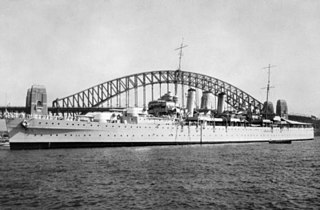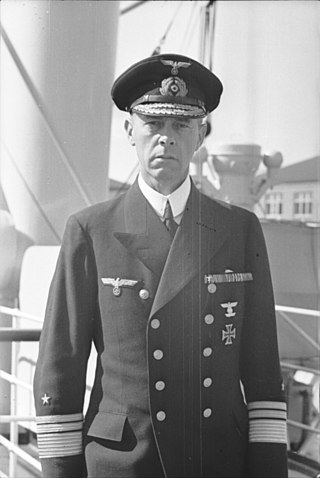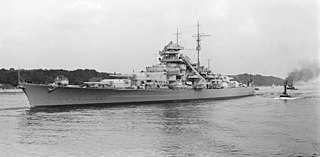
The Kriegsmarine was the navy of Nazi Germany from 1935 to 1945. It superseded the Imperial German Navy of the German Empire (1871–1918) and the inter-war Reichsmarine (1919–1935) of the Weimar Republic. The Kriegsmarine was one of three official branches, along with the Heer and the Luftwaffe, of the Wehrmacht, the German armed forces from 1935 to 1945.

German submarine U-552 was a Type VIIC U-boat built for Nazi Germany's Kriegsmarine for service during World War II. She was laid down on 1 December 1939 at Blohm & Voss in Hamburg as yard number 528, launched on 14 September 1940, and went into service on 4 December 1940. U-552 was nicknamed the Roter Teufel after her mascot of a grinning devil, which was painted on the conning tower. She was one of the more successful of her class, operating for over three years of continual service and sinking or damaging 35 Allied ships with 164,276 GRT and 1,190 tons sunk and 26,910 GRT damaged. She was a member of 21 wolf packs.

The Battle of the Falkland Islands was a First World War naval action between the British Royal Navy and Imperial German Navy on 8 December 1914 in the South Atlantic. The British, after their defeat at the Battle of Coronel on 1 November, sent a large force to track down and destroy the German cruiser squadron. The battle is commemorated every year on 8 December in the Falkland Islands as a public holiday.

SMS Gneisenau was an armored cruiser of the German Kaiserliche Marine, part of the two-ship Scharnhorst class. Named for the earlier screw corvette of the same name, the ship was laid down in June 1904 at the AG Weser shipyard in Bremen, launched in June 1906, and commissioned in March 1908. She was armed with a main battery of eight 21 cm (8.3 in) guns, a significant increase in firepower over earlier German armored cruisers, and she had a top speed of 22.5 knots. Gneisenau initially served with the German fleet in I Scouting Group, though her service there was limited owing to the British development of the battlecruiser by 1909, which the less powerful armored cruisers could not effectively combat.

HMS Dorsetshire was a County-class heavy cruiser of the British Royal Navy, named after the English county, now usually known as Dorset. The ship was a member of the Norfolk sub-class, of which Norfolk was the only other unit; the County class comprised a further eleven ships in two other sub-classes. Dorsetshire was built at the Portsmouth Dockyard; her keel was laid in September 1927, she was launched in January 1929, and was completed in September 1930. Dorsetshire was armed with a main battery of eight 8 in (203 mm) guns, and had a top speed of 31.5 knots.

Operation Rheinübung was the last sortie into the Atlantic by the new German battleship Bismarck and heavy cruiser Prinz Eugen on 18–27 May 1941, during World War II. This operation aimed to block Allied shipping to the United Kingdom as the previously successful Operation Berlin had done. After Bismarck had sunk HMS Hood during battle of the Denmark Strait, it culminated with the sinking of Bismarck, while Prinz Eugen escaped to port in occupied France. From that point on, Germans would rely only on U-boats to wage the Battle of the Atlantic.

HMS Norfolk was a County-class heavy cruiser of the Royal Navy; along with her sister ship Dorsetshire she was part of a planned four-ship subclass. She served throughout the Second World War, where she was involved in the sinking of the German Navy's battleships Bismarck and Scharnhorst.

The Battle of the North Cape was a Second World War naval battle that occurred on 26 December 1943, as part of the Arctic campaign. The German battleship Scharnhorst, on an operation to attack Arctic convoys of war materiel from the western Allies to the Soviet Union, was brought to battle and sunk by the Royal Navy's battleship HMS Duke of York with cruisers and destroyers, including an onslaught from the destroyer HNoMS Stord of the exiled Royal Norwegian Navy, off the North Cape, Norway.

The Scharnhorst class was a class of German battleships built immediately prior to World War II. The first capital ships of Nazi Germany's Kriegsmarine, it comprised two vessels: Scharnhorst and Gneisenau. Scharnhorst was launched first, and is considered to be the lead ship by some sources; they are also referred to as the Gneisenau class in some other sources, as Gneisenau was the first to be laid down and commissioned. They marked the beginning of German naval rearmament after the Treaty of Versailles. The ships were armed with nine 28 cm (11 in) SK C/34 guns in three triple turrets; plans to replace these with six 38 cm (15 in) SK C/34 guns in twin turrets were never realized.

Operation Berlin was a raid conducted by the two German Scharnhorst-class battleships against Allied shipping in the North Atlantic between 22 January and 22 March 1941. It formed part of the Battle of the Atlantic during World War II. The Scharnhorst and Gneisenau sailed from Germany, operated across the North Atlantic, sank or captured 22 Allied merchant vessels, and finished their mission by docking in occupied France. The British military sought to locate and attack the German battleships, but failed to damage them.

HMS Rawalpindi was a British armed merchant cruiser that was sunk in a surface action against the German battleships Scharnhorst and Gneisenau during the first months of the Second World War. Her captain was Edward Kennedy.

German submarine U-69 was the first Type VIIC U-boat of the German Navy (Kriegsmarine) during World War II. This meant that compared to previous U-boats, she could travel further afield for longer, with a payload of fourteen torpedoes, an 8.8 cm (3.5 in) deck gun for smaller vessels and a flak gun for use against aircraft. U-69 was very successful, sinking over 72,000 gross register tons (GRT) of Allied shipping in a career lasting two years, making her one of the longest surviving, continuously serving, U-boats. Her most notable attack was on the civilian ferry SS Caribou, which sank off the coast of Newfoundland in October 1942, killing 137 men, women and children. She was rammed and sunk by HMS Fame on 17 February 1943.

German submarine U-124 was a Type IXB U-boat of Nazi Germany's Kriegsmarine during World War II. She operated in the Atlantic as part of the 2nd U-boat flotilla, both west of Scotland and east of the eastern US coast. She was also present off northern South America.

German submarine U-201 was a Type VIIC U-boat of the Kriegsmarine in World War II.

German submarine U-106 was a Type IXB U-boat of Nazi Germany's Kriegsmarine that operated during World War II. She was laid down on 26 November 1939 at DeSchiMAG AG Weser in Bremen as yard number 969, launched on 17 June 1940 and commissioned on 24 September. She was armed with six torpedo tubes and a 10.5 cm SK C/32 naval gun. U-106 was assigned to the 2nd U-boat Flotilla on 24 September 1940, in which she would serve for nearly three years.

The Scharnhorst class was the last class of traditional armored cruisers built by the German Kaiserliche Marine. The class comprised two ships, Scharnhorst and Gneisenau. They were larger than the Roon-class cruisers that preceded them; the extra size was used primarily to increase the main armament of 21 cm (8.2 inch) guns from four to eight. The ships were the first German cruisers to reach equality with their British counterparts. The ships were named after 19th century Prussian army reformers, Gerhard von Scharnhorst and August von Gneisenau.

The Bismarck-class was a pair of fast battleships built for Nazi Germany's Kriegsmarine shortly before the outbreak of World War II. The ships were the largest and most powerful warships built for the Kriegsmarine; displacing more than 41,000 metric tons normally, they were armed with a battery of eight 38 cm (15 in) guns and were capable of a top speed of 30 knots. Bismarck was laid-down in July 1936 and completed in September 1940, while the keel of her sister ship, Tirpitz, was laid in October 1936 and work finished on February 1941. The ships were ordered in-response to the French Richelieu-class battleships, themselves laid-down in-response to the Italian Littorio-class battleships. The Bismarck-class was designed with the traditional role of engaging enemy battleships in home waters in mind, though the Oberkommando der Marine envisioned employing the ships as long-range commerce raiders against British shipping in the Atlantic Ocean. As such, their design represented the strategic confusion that dominated German naval construction in the 1930s.

Scharnhorst was a German capital ship, alternatively described as a battleship or battlecruiser, of Nazi Germany's Kriegsmarine. She was the lead ship of her class, which included her sister ship Gneisenau. The ship was built at the Kriegsmarinewerft dockyard in Wilhelmshaven; she was laid down on 15 June 1935 and launched a year and four months later on 3 October 1936. Completed in January 1939, the ship was armed with a main battery of nine 28 cm (11 in) C/34 guns in three triple turrets. Plans to replace these weapons with six 38 cm (15 in) SK C/34 guns in twin turrets were never carried out.

Gneisenau was a German capital ship, alternatively described as a battleship and battlecruiser, in Nazi Germany's Kriegsmarine. She was the second vessel of her class, which included her sister ship, Scharnhorst. The ship was built at the Deutsche Werke dockyard in Kiel; she was laid down on 6 May 1935 and launched on 8 December 1936. Her outfitting was completed in May 1938: she was armed with a main battery of nine 28 cm (11 in) C/34 guns in three triple turrets. At one point after construction had started, a plan had been approved to replace these weapons with six 38 cm (15 in) SK C/34 guns in twin turrets, but when it was realized that this would involve a lot of redesign, that plan was abandoned, and construction continued with the originally planned lower-calibre guns. The upgrade had been intended to be completed in the winter of 1940–41, but instead, due to the outbreak of World War II, that work was stopped.
SS Everalda was a Latvian Cargo ship and part of the Latvian Mercantile Marine during World War II that the German submarine U-158 shelled and sank on 23 June 1942 in the Atlantic Ocean 360 nautical miles (670 km) south south west of Bermuda while she was travelling from Philadelphia, Pennsylvania, United States to Rio de Janeiro, Brazil while carrying general cargo.

















